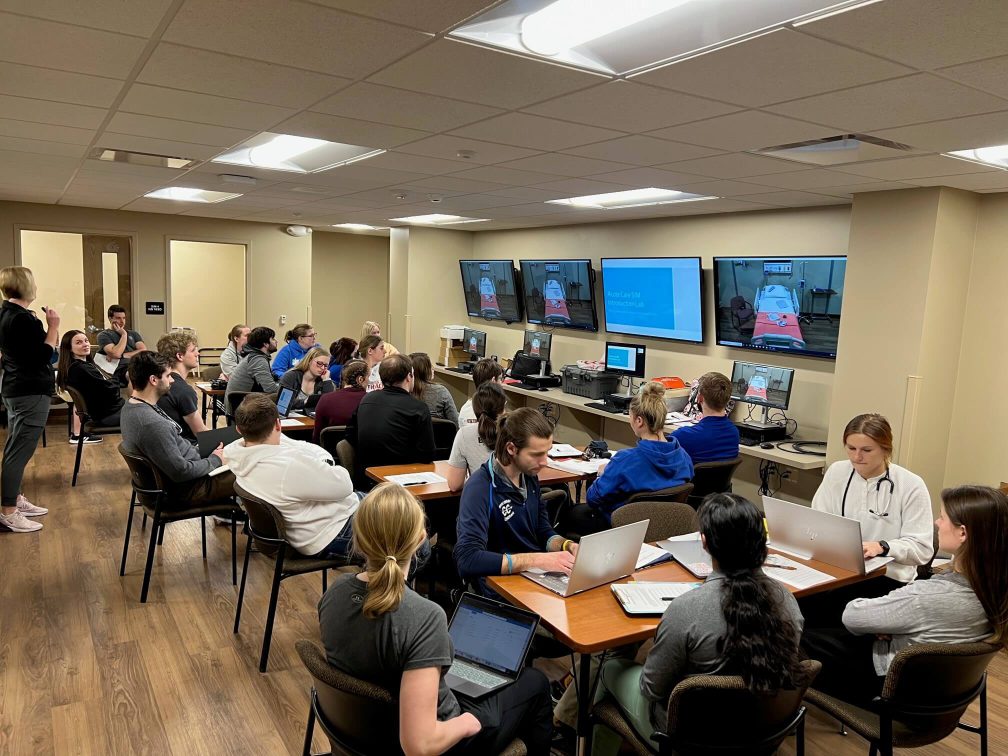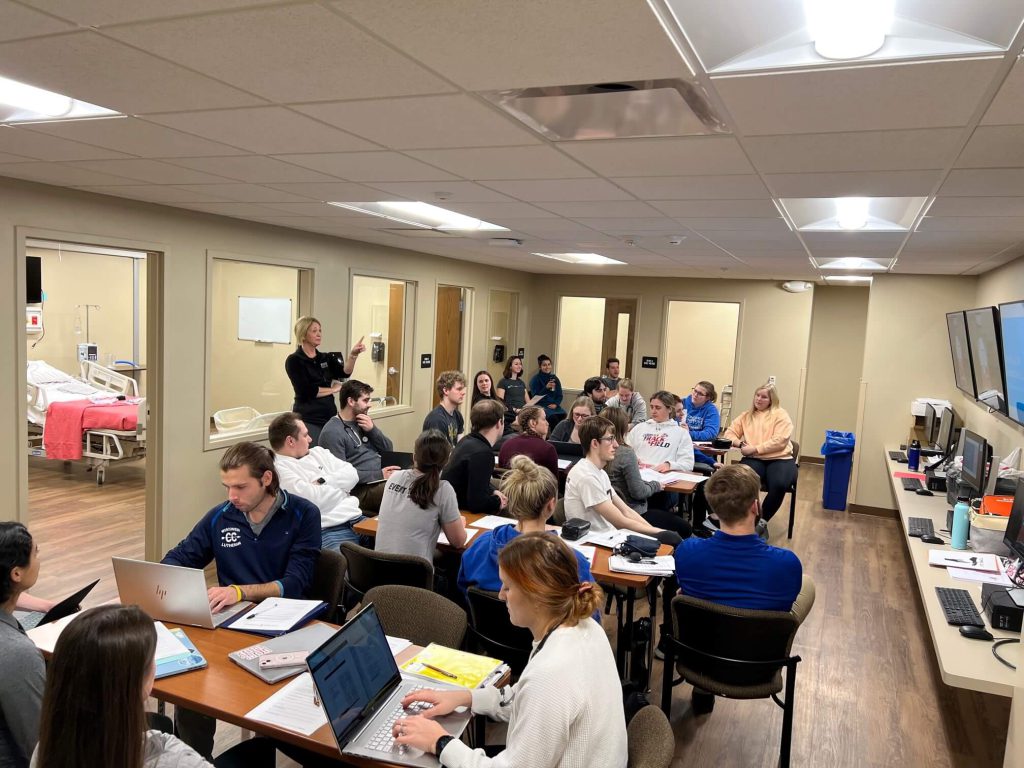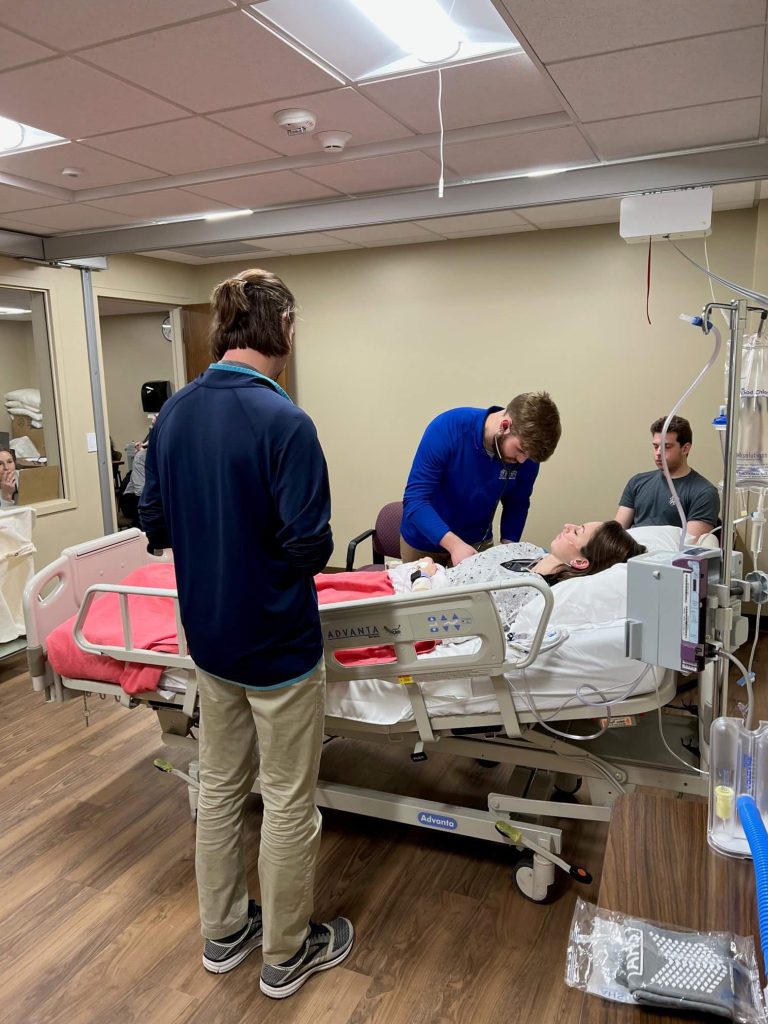
Learn how CUW’s PT Faculty use the new SIM Lab
What is a PT?
Physical therapists (PTs) serve patients in outpatient clinics, skilled nursing facilities, patient homes, and hospitals. Specifically, within a hospital PTs help patients with complex medical diagnoses who have been immobile in beds for long periods of time due to their illness medical treatments. Long-term inactivity can lead to long-term disability, a reduced quality of life, and additional health care costs.
What does a PT do in a hospital?
PTs are movement specialists who facilitate early movement with patients across the lifespan to reduce the negative impacts of bed rest and immobilization associated with illness. PTs play an essential role in patient management, rehabilitation, recovery and discharge planning.
With an aging patient population and increased prevalence of critical illness, how do student PTs learn the necessary acute care skills to be competent health care providers for this patient population?
Lectures and readings can provide students with some knowledge, but hands-on training is really important for student success. Acute care simulation lab learning is the gold standard in PT education. Simulation lab learning exposes students to a variety of patient scenarios and acute care equipment. It also increases cognitive and technical skills, behavioral performance, inter-professional communication abilities, critical thinking and confidence.

How has CUW created solutions?
The School of Health Professions recently dedicated an acute care simulation lab with 4 acute care rooms each equipped with a hospital bed, bedside chair, vitals monitor, IV poles, oxygen, lines and monitors. Each room has video technology allowing students in the discussion space to view activities on monitors. The variety of equipment allows faculty to create patient scenarios from children through older adults in simple to complex acute care situations. One simulation room has a ceiling lift donated by Guldmann Inc. which allows students to practice a variety of transfers in and out of bed for patients with limited mobility. This donation was facilitated by the Wisconsin Safe Patient Handling and Mobility Network.
Who teaches in the SIM Lab?
Dr. Stacy Stolzman was recently awarded a Concordia Intramural Teaching Grant (CITG). This allowed her to attend formal simulation training at Mayo Clinic in Rochester, MN. She was also able to purchase simulation lab equipment and develop multiple simulation scenarios. In her course Cardiopulmonary & Acute Care Physical Therapy, students now participate in standardized patient scenarios. They practice patient interview skills, inter-professional communication, identification of acute care equipment and mobility activities. Student outcomes will be assessed to determine the impact on performance within practical testing and future student clinical education.
Why is Simulation Learning Important?

Simulation learning focuses on creating a safe space to learn and make mistakes. Before each scenario, students prepare for the learning topic by reviewing research articles, textbook readings, and viewing online lectures. Each scenario starts with pre-brief activities including patient information, learning goals and role designation of all participating students and faculty.
During the scenarios, students perform skills in a close to real life acute care room with patient and healthcare actors. Professors allow time-outs to redirect activities or to allow students to ask for assistance and feedback from instructors. Additional students participate as observers and provide peer feedback. They end each scenario with a structured debrief time. This is where students reflect and share how they felt, what went well and what improvements could be made in the future. In addition, “SIM Lab” technology also allows recording of scenarios for future assessments.
The new curriculum within the simulation lab provides students with learning opportunities to increase critical thinking, competence and confidence for the vocation of acute care physical therapy. Students often report the noises of monitors, number of lines and the monitors connected to their patients are overwhelming. They also report being unaware of how to manage all of this while safely mobilizing their patients in intensive care units and hospital rooms. Simulation learning creates a safe place to increase acute care confidence for future clinicals within the program. With a critical need for PTs in acute care settings, Dr. Stolzman strives to share her passion for acute care to PT students and foster the next generation of acute care PT clinicians.
Many thanks to the numerous donors who contributed to the School of Health Professions Simulation Lab.
More questions about PT?
Check out some of our other blog posts about things like
The School of Health Professions (SHP) offers a wide variety of accredited programs at both the undergraduate and graduate level. Our programs are provided in a variety of teaching formats (face-to-face, online, blended) and curriculums emphasize service to the community and inter-professional collaboration. Students are able to work with community members very early in their educational experience. Explore your options!
—Stacy Stolzman, a pediatric physical therapist, is dedicated to teaching the next generation of physical therapy professionals through graduate coursework focused on how a PT addresses promotion of normal physiology and rehabilitation of pathophysiology across the lifespan. In addition, she engages students in simulation learning within cardiopulmonary and acute care physical therapy using evidence-based practice.